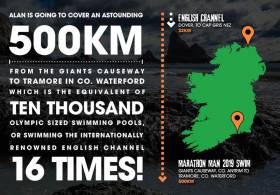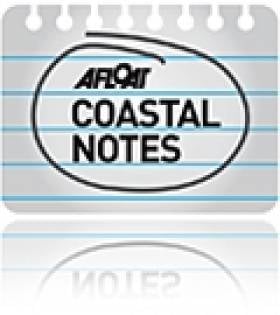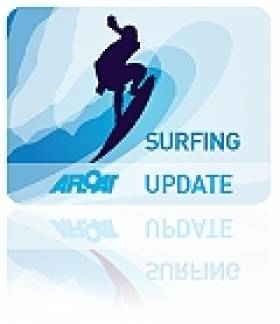Displaying items by tag: Giant's Causeway
‘Marathon Man’ To Take On 500km Charity Swimming Challenge From Causeway Coast To Tramore
This summer, Waterford’s ‘marathon man’ will attempt a 500km open water swimming challenge from the Causeway Coast to Tramore to raise funds for stroke and cancer support.
Alan Corcoran made headlines in 2012 when be became the first man to run a lap of the island of Ireland in tribute to his father, former FAI president Milo Corcoran, who suffered a stroke the year before.
After his father’s death from cancer in 2016, Alan embarked on another ambitious undertaking — to swim from the top to the bottom of Ireland.
Alan first attempted the swim in 2017, but came acropper some 200km in when his support boat sank to shy of the border.
Nevertheless, his efforts still raised €13,000 for his chosen charities, and firmed his resolve to take on the challenge again in aid of the Irish Heart Foundation and Solas Cancer Support Centre.
“Losing my dad has been the toughest experience of my life,” says Alan. “Out of the darkness I am determined to grasp any opportunity to create some positives.”
He adds: “The swim is my small way of feeling like I’m taking some meaningful action.”
As Alan prepares to set out from the Giant’s Causeway on Saturday 1 June, he is also seeking a skipper to sail his 32ft Jeanneau Attalia as a support vessel for the swimming challenge. For more details see the Afloat Marine Market HERE.
Young Kayakers Recognised at NI Clean Coast Awards
#COASTAL NOTES - A group of young kayaking enthusiasts from Northern Ireland have taken the top spot in their category at the Coca-Cola Clean Coast Awards, as the Coleraine Times reports.
The Causeway Coast Kayak Association comprises 150 young people learning canoeing and other skills on the Causeway Coast in North Antrim.
They were recognised for their involvement in coastal cleanups around Ramore Head and along inland waterways such as the rivers Roe and Bann.
NI Environment Minister Attwood, who was on hand to present the award, said: “It is great to see community and youth groups taking pride in their own neighbourhood and doing something about littering which is such a blight on our coast and around our inland waterways.”
The Coleraine Times has more on the story HERE.
Up Close and Personal with NI Big Wave Surfer Al Mennie
#SURFING - Top press photographer Charles McQuillan recently travelled to Northern Ireland to capture big wave surfing pro Al Mennie in training for the winter season, as The Irish Times reports.
McQuillan set out to document every aspect of Mennie's surfing life on the north Antrim coast, from the pre-dawn starts and protein-heavy breakfasts to the gruelling solo training sessions and the thrill of the surf itself.
And he made sure to get up close and personal with his subject, using waterproofing equipment to photograph him underwater - and even following him on a jet-ski to the secret offshore surfing spots known only to Mennie and his fellow big wavers.
The snapper described the surfer as "incredibly at home" in the water. Not surprising for a man used to taking on the enormous Finn McCool swells off the Giant's Causeway, or paddling across the North Channel for charity as he did this past spring (see more pics of Mennie surfing HERE).
As Mennie tells the Belfast Telegraph, he has the good fortune to be able to ride “the biggest, scariest waves on the planet” in his own backyard.
It comes at a price - Mennie must be in peak physical condition at all times, as one never knows when the big one might come - but it's a price he's more than willing to pay, with his body and his mind.
“Big-wave surfing is at least 80 per cent to do with your mind, and the physical aspect boosts the mental side," he tells The Irish Times. "I don’t feel 100 per cent in myself unless I’m training properly.”
Meanwhile, The Irish Times also highlights the best places to get your wetsuit on and go surfing in Ireland during the increasingly popular winter season, with schools in the hotspots of Lahinch in Co Clare - the focus of a new book by journalist Keith Duggan - and Bundoran, Co Donegal upgrading to meet the demand.
And even if its waves aren't up to scratch, the east coast still is getting some of the action, with stand-up paddleboarding (SUP) becoming the latest way to ease into the sport.
New Giant's Causeway Visitors Centre Opens
#GIANT'S CAUSEWAY - The new Giant's Causeway visitors centre has opened to the public in Co Antrim in what's expected to be a big boost to tourism in the area.
Located close to the UNESCO World Heritage Site, the £18.5 million (€23 million) facility was designed to complement the coastal region's dramatic vistas, with a grass roof that allows it to blend in with the surrounding landscape, and columns that echo the causeway's thousands of naturally formed hexagonal basalt pillars.
As The Irish Times reports, the centre illustrates the story of the stones and the legend of Finn McCool and his Scottish rival who are said to have created the causeway during a mythical battle.
Already and award-winner for innovative design and sustainable features, the National Trust centre - located nine miles from Portrush - looks to welcome up to 780,000 visitors a year.
The Daily Telegraph has images of the new visitors centre and more on the story HERE.
Al Mennie's Epic Charity Paddle from Giant's Causeway
#SURFING - Northern Irish surf pro Al Mennie will be taking on a different challenge later this month, when he sets out to paddle a surfboard from the Giant's Causeway to Scotland in the name of charity.
"It will be the northernmost crossing of its type in the world," says Mennie of the 25-mile route from Antrim to the Scottish island of Islay.
"I will have to deal with freezing cold temperatures, large open ocean swell, potentially high winds and the deadly currents around a well known navigational hazard of a North Atlantic island."
Mennie will be on his own except for a support boat carrying food and water. He will be wearing a 6mm wetsuit and crossing the most dangerous stretch of water around the Irish coastline, "known for its extremely deadly currents as the Irish Sea tides drain between Rathlin Island and Northern Ireland".
The NI surfer is embarking on the challenge in aid of Northern Ireland Chest Heart and Stroke, which is a charity close to his own heart.
"My dad died suddenly of a heart attack aged 50 and I know lots of people who have also lost loved ones to heart problems too," he says, "so I really want to help make a difference by raising money for this charity."
For more details or to make a donation, visit the charity page at Al Mennie's website HERE.
Al and Cotty Take On Giant Wave
The surfing website MagicSeaweed has posted a breathtaking pictorial of boarders Al Mennie and Andrew Cotton taking on the incredible Finn MacCools wave at the Giant's Causeway.
"The funny thing is this wave has been breaking right under our noses for years at Northern Ireland's premier tourist spot!" said Mennie. "It's one of those mythical places people often mention, wondering if there are waves out here."
'Al' and 'Cotty' were among the surfers who discovered the now-famous Prowlers wave off the west coast of Ireland last year - the exact location of which is still a closely-guarded secret. SEE VIDEO BELOW
More photos and vide on this story HERE





























































